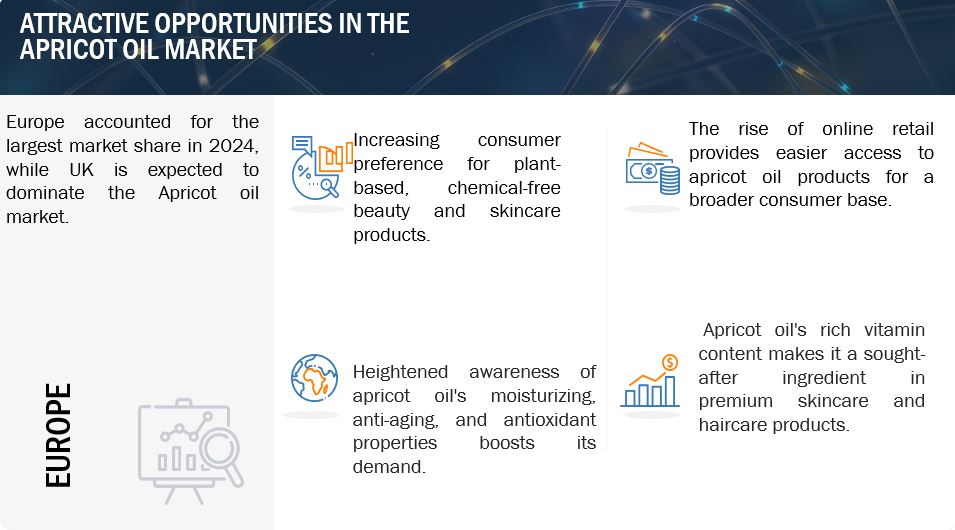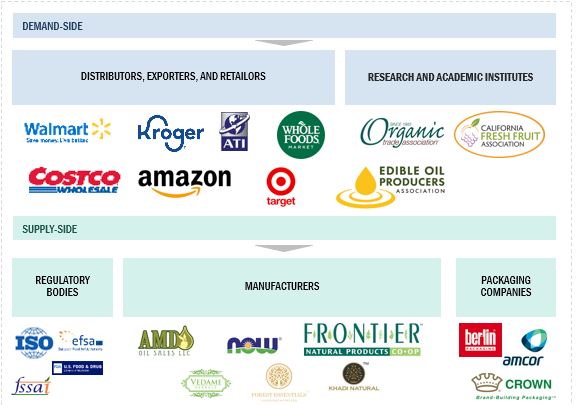Apricot Oil Market
The apricot oil market is experiencing significant growth, fueled by increasing consumer awareness of natural and plant-based ingredients in personal care, cosmetics, and wellness products. Extracted from apricot kernels, apricot oil is rich in essential fatty acids, vitamins A and E, and antioxidants. These properties make it highly sought after for its moisturizing, anti-inflammatory, and anti-ageing benefits. Apricot oil is versatile and finds applications across various industries, including cosmetics, skincare, pharmaceuticals, and food and beverages. As demand for organic and cold-pressed oils rises, manufacturers are concentrating on product innovation and sustainable sourcing practices, which contribute to the expansion of the global apricot oil market. Furthermore, trends in aromatherapy and natural remedies are boosting the popularity of apricot oil, particularly in regions like North America and Europe, where consumers prefer clean beauty and wellness products. The market is also witnessing a surge in online retail channels, providing consumers with easier access to premium apricot oil products.
Global Apricot Oil Market Trend


Market Dynamics
Drivers: Growing Consumer Preference for Natural and Organic Products
The growing consumer preference for natural and organic products has significantly contributed to the expansion of the apricot oil market. As awareness of the benefits of natural ingredients continues to rise, particularly in the cosmetics and skincare sectors, more consumers are seeking plant-based alternatives such as apricot oil. According to a report by the Organic Trade Association, the market for organic personal care products is projected to grow at a compound annual growth rate (CAGR) of 9.8% from 2023 to 2030, indicating a clear trend toward organic and sustainably sourced ingredients. Apricot oil, especially cold-pressed varieties, is becoming increasingly popular due to its rich content of essential fatty acids, as well as vitamins A and E, and antioxidants. This shift is particularly noticeable in markets like North America and Europe, where consumers are opting for clean beauty products that are free from synthetic chemicals. The rapid growth of the global organic skincare market is further driving the demand for organic oils, including apricot oil, in personal care formulations. This upward trend is encouraging manufacturers to innovate and expand their product lines to include premium, cold-pressed, organic apricot oil aimed at health-conscious consumers
Restraints: High Cost of Organic and Cold-Pressed Apricot Oil
The higher cost of organic and cold-pressed apricot oil significantly limits its widespread adoption, especially among price-sensitive consumers. The production of cold-pressed apricot oil is more labor-intensive and requires specialized equipment to extract the oil without using heat or chemicals. This process helps preserve its nutritional value but also increases production costs. Furthermore, obtaining organic certification involves strict regulatory compliance, which can be both time-consuming and expensive for producers. These factors drive up the price of organic and cold-pressed apricot oil, often positioning them as premium products in the market. Although there is a growing demand for high-quality, natural ingredients, the higher price point can restrict the customer base to affluent consumers or niche markets, thus hindering broader market penetration. This cost barrier may also pose challenges for manufacturers looking to scale their operations or compete with more affordable alternatives, such as refined apricot oil or other plant-based oils. Therefore, balancing production costs with consumer affordability remains a challenge in expanding the market for organic and cold-pressed apricot oil.
Opportunities: E-commerce Growth
The rapid growth of e-commerce presents a significant opportunity for apricot oil manufacturers to connect with a broader and more diverse audience. As consumers increasingly turn to online platforms to purchase health and wellness products, the convenience and accessibility of e-commerce channels have become essential drivers of market growth. According to the International Trade Administration, global B2C e-commerce revenue is projected to reach USD 5.5 trillion by 2027, with a steady compound annual growth rate (CAGR) of 14.4%.
This expansion is particularly advantageous for apricot oil brands, allowing them to easily reach consumers worldwide without the need for extensive physical retail networks. E-commerce also provides manufacturers with valuable insights into consumer preferences and purchasing behavior, enabling them to tailor their marketing strategies and product offerings accordingly. Moreover, the rise of digital marketing, influencer collaborations, and targeted advertising on platforms like Instagram and Amazon has increased the visibility of natural products such as apricot oil, further driving demand. This shift toward online shopping offers manufacturers a cost-effective way to expand their customer base and boost sales, especially in regions where access to physical retail stores may be limited.
Challenges: Competition from Other Plant-Based Oils
Apricot oil faces significant competition from well-established plant-based oils such as almond, jojoba, and argan oil, which offer similar benefits and are more widely recognized by consumers. These oils have built strong brand equity and consumer trust due to their long-standing presence, particularly in the cosmetics and skincare industries. For example, almond oil is popular for its nourishing properties and is a common ingredient in moisturizers. Jojoba oil is favored for its ability to balance oil production and provide hydration without clogging pores. Similarly, argan oil is renowned for its high vitamin E content and is heavily marketed for its anti-aging and hair care benefits. These oils often dominate both physical and online retail spaces, making it challenging for apricot oil to stand out, despite having comparable benefits such as hydration, anti-inflammatory properties, and high vitamin content. The familiarity of these oils among consumers, coupled with their strong market presence, creates a barrier for apricot oil brands. These brands must invest in educating the market about their unique advantages and differentiating their products to capture a larger share of the market.
Market Ecosystem

The cold-pressed apricot oil in the product type segment as the fastest-growing market for Apricot oil market during the forecast period.
In the apricot oil market, cold-pressed apricot oil typically holds the largest share among product types. This is because cold-pressed oil is regarded as the highest quality, as it preserves the maximum nutritional value and beneficial properties of the apricot kernel without using heat or chemicals. Cold-pressed apricot oil is particularly favored in the cosmetic and skincare industries due to its natural and pure composition, making it ideal for premium and organic product lines. Moreover, the increasing consumer demand for natural, chemical-free products further enhances the popularity of cold-pressed apricot oil, especially in high-end skincare and wellness products. While refined apricot oil is also available in the market, its share is smaller compared to cold-pressed varieties, which align with the growing trend toward organic and sustainable ingredients in beauty and health products.
In terms of application, cosmetics and personal care account for the largest share of the Apricot oil market
In the apricot oil market, the cosmetics and personal care sector holds the largest share within the application segmentation. Apricot oil’s moisturizing, anti-inflammatory, and anti-aging properties make it an ideal ingredient in skincare and haircare products. It is commonly used in creams, lotions, serums, shampoos, and conditioners, particularly those marketed as natural, organic, or free from synthetic chemicals. This growing demand for natural beauty products is fueling the prominence of apricot oil in the cosmetics industry..
The Europe region market for Apricot oil market holds the largest market share during the forecast period.
In the apricot oil market, Europe holds the largest share by region, driven by the high demand for natural and organic skincare products, particularly in countries like France, Germany, and the UK. European consumers have a strong preference for premium, sustainable, and organic beauty products, making the region a significant market for apricot oil, particularly in the cosmetics and personal care sectors. Additionally, the region's established retail networks and online platforms facilitate the widespread availability of apricot oil, further boosting its market penetration.

Key Market Players
The key players in this market include AMD Oil Sales LLC, Plantlife Natural Body Care, NOW Foods, Frontier Natural Products Co-op, Vedame Herbals, Forest Essentials, Greenwood Essential, Khadi Natural, Starwest Botanicals, Aura Cacia, Life-Flo, Nature's Alchemy, Aadhunik Ayurveda Vitals, AG Organica, and Hima India Biotech Pvt. Ltd.
Recent Developments
- In April 2023, Eni, the Italian giant, started producing apricot oil for biorefining in Kenya. They have established an oilseed collection and pressing facility, called an agri-hub, in Makueni, Kenya, with an initial production capacity of 15,000 tons
- In April 2022, Trikuta Oils, a wholesale business in Jammu, India, introduced an exotic range of organic oils, including almond, apricot and walnut. The new range is sourced from Jammu, Kashmir & Ladakh hills.
Frequently Asked Questions (FAQ):
Which region is projected to account for the largest share in the apricot oil market?
Europe dominated the apricot oil market, worth USD XX billion in 2024, and is projected to reach USD XX billion by 2029, at a CAGR of XX% during the forecast period.
What is the current size of the global apricot oil market?
The global apricot oil market was valued at USD XX billion in 2024. It is projected to reach USD XX billion by 2029, recording a CAGR of XX% during the forecast period.
Who are the key players in the market?
The key players in this market AMD Oil Sales LLC, Plantlife Natural Body Care, NOW Foods, Frontier Natural Products Co-op, Vedame Herbals, Forest Essentials, Greenwood Essential, Khadi Natural, Starwest Botanicals, Aura Cacia, Life-Flo, Nature's Alchemy, Aadhunik Ayurveda Vitals, AG Organica, and Hima India Biotech Pvt. Ltd.
What are the factors driving the apricot oil market?
- Rising Demand for Natural and Organic Products: Increasing consumer preference for plant-based, chemical-free beauty and skincare products.
- Growing Awareness of Apricot Oil’s Health Benefits: Heightened awareness of apricot oil's moisturizing, anti-aging, and antioxidant properties boosts its demand.
- Expansion of E-commerce Platforms: The rise of online retail provides easier access to apricot oil products for a broader consumer base.
- Increasing Use in Personal Care and Cosmetics: Apricot oil's rich vitamin content makes it a sought-after ingredient in premium skincare and haircare products.
- Rising Popularity of Organic Food and Dietary Supplements: Apricot oil's nutritional benefits drive its use in health-conscious food products and supplements.
- Sustainability Trends in Consumer Goods: Growing emphasis on eco-friendly, sustainably sourced ingredients like cold-pressed apricot oil.
Which segment accounted for the largest apricot oil market share?
Cold-Pressed Apricot Oil holds the largest market share due to its high nutrient retention and growing demand for natural, unprocessed oils, particularly in the cosmetics and skincare industries.

TABLE OF CONTENTS
1. INTRODUCTION















Growth opportunities and latent adjacency in Apricot Oil Market